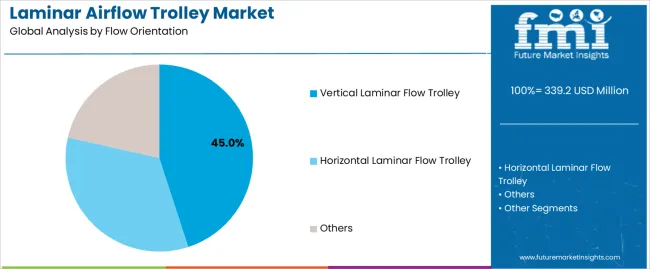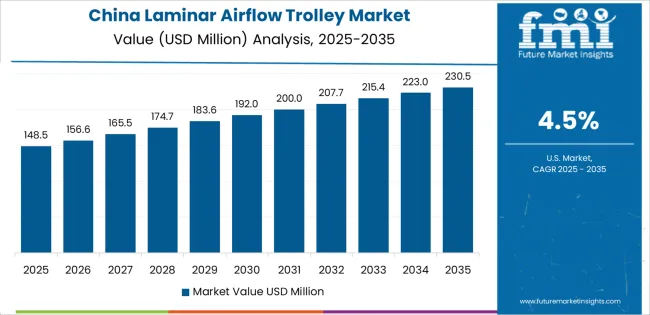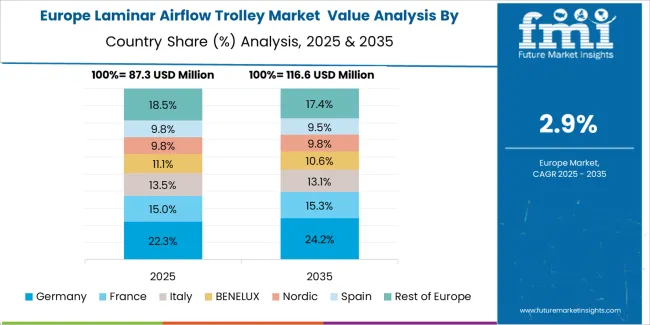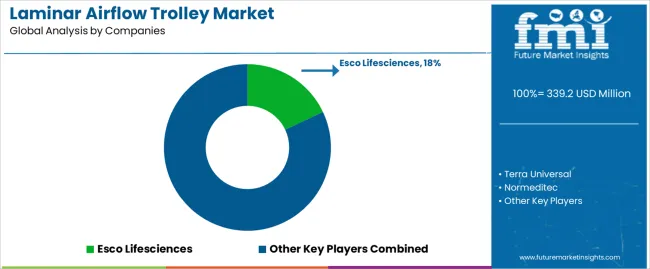The global laminar airflow trolley market is valued at USD 339.2 million in 2025. It is slated to reach USD 469.3 million by 2035, recording an absolute increase of USD 130.1 million over the forecast period. This translates into a total growth of 38.4%, with the laminar airflow trolley market forecast to expand at a CAGR of 3.3% between 2025 and 2035. The overall market size is expected to grow by approximately 1.38 times during the same period, supported by increasing demand for contamination control equipment in healthcare and pharmaceutical facilities, growing adoption of laminar airflow trolleys for sterile material handling and cleanroom operations, and rising emphasis on infection prevention and quality assurance across diverse medical, pharmaceutical manufacturing, food processing, and laboratory applications.
Between 2025 and 2030, the laminar airflow trolley market is projected to expand from USD 339.2 million to USD 398.9 million, resulting in a value increase of USD 59.7 million, which represents 45.9% of the total forecast growth for the decade. This phase of development will be shaped by increasing healthcare facility modernization and infection control requirements, rising demand for sterile material transport solutions in pharmaceutical manufacturing and hospital environments, and growing emphasis on cleanroom standards and contamination prevention programs. Healthcare facility operators and pharmaceutical manufacturers are expanding their laminar airflow trolley capabilities to address the growing demand for reliable and effective solutions that ensure sterile conditions and operational compliance.
From 2030 to 2035, the laminar airflow trolley market is forecast to grow from USD 398.9 million to USD 469.3 million, adding another USD 70.4 million, which constitutes 54.1% of the overall ten-year expansion. This period is expected to be characterized by the expansion of pharmaceutical manufacturing capacity and biologics production facilities, the development of advanced filtration technologies and smart monitoring systems, and the growth of specialized applications for sterile compounding and aseptic processing operations. The growing adoption of automation integration and digital tracking capabilities will drive demand for laminar airflow trolleys with enhanced performance and operational monitoring features.
Between 2020 and 2025, the laminar airflow trolley market experienced steady growth, driven by increasing infection control awareness and growing recognition of laminar airflow trolleys as essential equipment for maintaining sterile environments and preventing contamination in diverse healthcare and pharmaceutical manufacturing applications. The laminar airflow trolley market developed as hospital administrators and pharmaceutical quality managers recognized the potential for laminar airflow trolley technology to protect materials from airborne contamination, ensure sterile transport, and support quality objectives while meeting stringent regulatory requirements. Technological advancement in HEPA filtration and trolley design began emphasizing the critical importance of maintaining air cleanliness and operational reliability in demanding healthcare environments.

| Metric | Value |
|---|---|
| Estimated Value in (2025E) | USD 339.2 million |
| Forecast Value in (2035F) | USD 469.3 million |
| Forecast CAGR (2025 to 2035) | 3.3% |
Market expansion is being supported by the increasing global demand for contamination control equipment driven by infection prevention requirements and pharmaceutical quality standards, alongside the corresponding need for specialized transport systems that can enhance sterile material protection, enable compliant handling operations, and maintain air quality across various medical facilities, pharmaceutical manufacturing, food processing, and laboratory applications. Modern healthcare facility managers and pharmaceutical quality professionals are increasingly focused on implementing laminar airflow trolley solutions that can maintain sterile conditions, prevent contamination exposure, and provide consistent performance in critical operational environments.
The growing emphasis on patient safety and product quality is driving demand for laminar airflow trolleys that can support infection prevention strategies, enable aseptic processing requirements, and ensure comprehensive contamination control. Equipment manufacturers' preference for transport systems that combine air filtration effectiveness with operational mobility and regulatory compliance is creating opportunities for innovative laminar airflow trolley implementations. The rising influence of biologics manufacturing and sterile compounding is also contributing to increased adoption of laminar airflow trolleys that can provide superior contamination protection without compromising operational efficiency or cleanroom integrity.
The laminar airflow trolley market is segmented by flow orientation, application, and region. By flow orientation, the laminar airflow trolley market is divided into vertical laminar flow trolley, horizontal laminar flow trolley, and others. Based on application, the laminar airflow trolley market is categorized into medical, food, and others. Regionally, the laminar airflow trolley market is divided into East Asia, Europe, North America, South Asia, Latin America, Middle East & Africa, and Eastern Europe.

The vertical laminar flow trolley segment is projected to hold the largest market share in 2025, accounting for approximately 45% of the laminar airflow trolley market, reaffirming its role as the preferred flow configuration for sterile material transport and pharmaceutical handling applications. Healthcare facility operators and pharmaceutical manufacturers increasingly utilize vertical laminar flow trolleys for their superior contamination protection, effective particle removal characteristics, and proven performance in maintaining sterile conditions while enabling operational flexibility. Vertical flow technology's proven effectiveness and widespread adoption directly address the industry requirements for reliable contamination control and effective material protection across diverse healthcare platforms and pharmaceutical operations.
This flow orientation forms the foundation of modern sterile material handling, as it represents the configuration with the greatest contribution to contamination prevention and established performance record across multiple healthcare applications and pharmaceutical environments. Healthcare industry investments in infection control technologies continue to strengthen adoption among hospital operators and pharmaceutical manufacturers. With regulatory pressures requiring stringent contamination control and proven effectiveness, vertical laminar flow trolleys align with both safety objectives and compliance requirements, making them the central component of comprehensive sterile material handling strategies.

The medical application segment is projected to represent the largest share, approximately 50%, of laminar airflow trolley demand in 2025, underscoring its critical role as the primary driver for laminar airflow trolley adoption across hospital pharmacies, operating room supply areas, and sterile processing departments. Healthcare facility operators prefer laminar airflow trolleys for material transport due to their exceptional contamination protection capabilities, infection prevention benefits, and ability to maintain sterile conditions while supporting patient safety and regulatory compliance objectives. Positioned as essential equipment for modern healthcare facilities, laminar airflow trolleys offer both safety advantages and operational benefits.
The segment is supported by continuous innovation in filtration technologies and the growing availability of advanced trolley designs that enable superior air cleanliness with enhanced mobility and reduced maintenance requirements. Medical equipment manufacturers are investing in comprehensive product development programs to support increasingly stringent infection control standards and healthcare facility requirements for reliable sterile transport solutions. As healthcare-associated infection prevention intensifies and patient safety standards evolve, the medical application will continue to dominate the laminar airflow trolley market while supporting advanced contamination control utilization and healthcare quality optimization strategies.
The laminar airflow trolley market is advancing steadily due to increasing demand for contamination control equipment driven by infection prevention priorities and growing adoption of aseptic processing practices that require specialized transport systems providing enhanced sterile protection and air quality management benefits across diverse medical facilities, pharmaceutical manufacturing, food processing, and laboratory applications. The laminar airflow trolley market faces challenges, including high equipment costs and capital budget limitations, competition from alternative contamination control methods and stationary systems, and operational constraints related to filter maintenance requirements and power supply dependencies. Innovation in filtration technologies and smart monitoring systems continues to influence product development and market expansion patterns.
The growing production of pharmaceutical products is driving demand for specialized contamination control equipment that addresses sterile manufacturing requirements including material transfer protection, aseptic processing support, and cleanroom environment maintenance. Modern pharmaceutical facilities require advanced laminar airflow trolley solutions that deliver superior contamination protection across multiple operational scenarios while maintaining compliance and operational efficiency. Pharmaceutical equipment suppliers are increasingly recognizing the competitive advantages of laminar airflow trolley integration for quality assurance enhancement and regulatory compliance support, creating opportunities for innovative transport systems specifically developed for next-generation pharmaceutical manufacturing applications.
Modern laminar airflow trolley manufacturers are incorporating digital monitoring systems and validation capabilities to enhance operational assurance, support regulatory compliance, and address comprehensive quality management objectives through real-time air velocity monitoring and filter performance tracking. Leading equipment manufacturers are developing sensor-equipped trolleys with continuous airflow verification, implementing data logging systems, and advancing alarm technologies that improve contamination protection and compliance documentation. These technologies improve operational assurance while enabling new quality benefits, including predictive maintenance scheduling, performance trend analysis, and automated compliance reporting. Advanced monitoring integration also allows operators to support comprehensive regulatory objectives and quality excellence beyond traditional manual verification methods.
The expansion of specialized pharmaceutical applications, diverse healthcare requirements, and operational flexibility needs is driving development of modular laminar airflow trolleys with precisely engineered configurations and exceptional customization capabilities. These advanced systems require specialized designs with optimized airflow patterns that address specific application requirements, creating premium market segments with differentiated value propositions. Manufacturers are investing in advanced computational fluid dynamics capabilities and application testing systems to serve emerging specialized applications while supporting innovation in healthcare facility design and pharmaceutical manufacturing industries.
<
| Country | CAGR (2025-2035) |
|---|---|
| China | 4.5% |
| India | 4.1% |
| Germany | 3.8% |
| Brazil | 3.5% |
| United States | 3.1% |
| United Kingdom | 2.8% |
| Japan | 2.5% |
The laminar airflow trolley market is experiencing solid growth globally, with China leading at a 4.5% CAGR through 2035, driven by expanding healthcare infrastructure, growing pharmaceutical manufacturing capacity, and increasing adoption of contamination control equipment in hospitals and production facilities. India follows at 4.1%, supported by healthcare facility expansion, pharmaceutical industry growth, and rising quality standards adoption. Germany shows growth at 3.8%, emphasizing pharmaceutical manufacturing excellence, healthcare quality standards, and advanced cleanroom technology requirements.
Brazil demonstrates 3.5% growth, supported by healthcare infrastructure development, pharmaceutical sector expansion, and infection control awareness growth. The United States records 3.1%, focusing on healthcare quality improvement, pharmaceutical compliance requirements, and facility modernization programs. The United Kingdom exhibits 2.8% growth, emphasizing infection prevention standards and pharmaceutical manufacturing quality. Japan shows 2.5% growth, supported by healthcare technology sophistication and pharmaceutical quality control emphasis.
The report covers an in-depth analysis of 20 countries, with top-performing countries highlighted below.

Revenue from laminar airflow trolleys in China is projected to exhibit exceptional growth with a CAGR of 4.5% through 2035, driven by expanding healthcare infrastructure and rapidly growing pharmaceutical manufacturing capacity supported by government healthcare improvement initiatives and pharmaceutical industry development policies. The country's massive healthcare sector expansion and increasing investment in quality control technologies are creating substantial demand for laminar airflow trolley solutions. Major medical equipment manufacturers and pharmaceutical supply companies are establishing comprehensive production capabilities to serve both domestic markets and export opportunities.
Demand for laminar airflow trolleys in India is expanding at a CAGR of 4.1%, supported by the country's healthcare facility expansion, growing pharmaceutical manufacturing sector, and increasing demand for quality control equipment driven by regulatory compliance requirements and international quality standards adoption. The country's comprehensive healthcare development and pharmaceutical industry growth are driving laminar airflow trolley adoption throughout diverse facility sectors. Leading medical equipment distributors and international manufacturers are establishing distribution and service facilities to address growing domestic demand.
Revenue from laminar airflow trolleys in Germany is anticipate to grow at a CAGR of 3.8%, supported by the country's pharmaceutical manufacturing excellence, strict healthcare quality standards, and strong emphasis on contamination control and cleanroom technologies. The nation's technical sophistication and regulatory rigor are driving laminar airflow trolley capabilities throughout pharmaceutical and healthcare sectors. Leading equipment manufacturers and facility service providers are investing extensively in advanced designs and specialized applications.
Demand for laminar airflow trolleys in Brazil is expanding at a CAGR of 3.5%, supported by the country's healthcare infrastructure development, pharmaceutical sector expansion, and growing adoption of infection control best practices. The nation's comprehensive healthcare system development and pharmaceutical industry growth are driving demand for effective laminar airflow trolley solutions. Medical equipment distributors and pharmaceutical supply companies are investing in capabilities to serve expanding healthcare and manufacturing sectors.
Revenue from laminar airflow trolleys in the United States is projected to grow at a CAGR of 3.1%, supported by the country's focus on healthcare quality improvement, established pharmaceutical compliance standards, and growing emphasis on infection prevention and facility modernization programs. The nation's comprehensive healthcare regulatory framework and pharmaceutical manufacturing excellence are driving demand for reliable laminar airflow trolley solutions. Equipment manufacturers and healthcare facility service providers are investing in technology development and distribution capabilities to serve diverse healthcare markets.
Demand for laminar airflow trolleys in the United Kingdom is expanding at a CAGR of 2.8%, driven by the country's infection prevention emphasis, healthcare quality standards, and growing focus on contamination control in medical and pharmaceutical facilities. The nation's healthcare system structure and quality frameworks are supporting investment in effective contamination control technologies. Medical equipment suppliers and healthcare facility service providers are establishing capabilities for equipment supply and maintenance support programs.
Revenue from laminar airflow trolleys in Japan is anticipated to grow at a CAGR of 2.5%, supported by the country's healthcare technology sophistication, pharmaceutical quality control emphasis, and strong focus on contamination prevention and operational excellence. Japan's technological excellence and quality standards are driving demand for advanced laminar airflow trolley systems. Equipment manufacturers and healthcare facility management companies are investing in specialized technologies suitable for precision healthcare environments.

The laminar airflow trolley market in Europe is projected to grow from USD 120.4 million in 2025 to USD 159.5 million by 2035, registering a CAGR of 2.9% over the forecast period. Germany is expected to maintain leadership with a 29.7% market share in 2025, moderating to 29.4% by 2035, supported by pharmaceutical manufacturing strength, healthcare quality standards, and cleanroom technology excellence.
France follows with 18.6% in 2025, projected at 18.8% by 2035, driven by pharmaceutical industry, hospital modernization programs, and healthcare quality requirements. The United Kingdom holds 16.3% in 2025, declining slightly to 16.1% by 2035 due to healthcare sector adjustments. Italy commands 12.8% in 2025, rising to 13.0% by 2035, while Spain accounts for 9.4% in 2025, reaching 9.6% by 2035 aided by healthcare expansion and pharmaceutical facilities.
Switzerland maintains 6.2% in 2025, up to 6.4% by 2035 due to pharmaceutical manufacturing excellence and biotechnology sector. The Rest of Europe region, including Nordic countries, Netherlands, Belgium, and other markets, is anticipated to hold 7.0% in 2025 and 6.7% by 2035, reflecting steady development in healthcare quality improvement, pharmaceutical manufacturing, and contamination control technology adoption.

The laminar airflow trolley market is characterized by competition among specialized cleanroom equipment manufacturers, medical equipment suppliers, and pharmaceutical equipment producers. Companies are investing in filtration technology development, trolley design enhancement, product range expansion, and application-specific configuration optimization to deliver high-performance, reliable, and cost-effective laminar airflow trolley solutions. Innovation in HEPA filtration systems, monitoring technologies, and ergonomic design features is central to strengthening market position and competitive advantage.
Esco Lifesciences leads the laminar airflow trolley market with comprehensive cleanroom equipment solutions with a focus on pharmaceutical applications, quality manufacturing, and global service capabilities across diverse healthcare and pharmaceutical manufacturing applications. Terra Universal provides cleanroom and contamination control equipment with emphasis on customization and application versatility. Normeditec delivers medical equipment solutions with focus on healthcare facility requirements and infection control. V-Mac Engineers offers pharmaceutical equipment with emphasis on manufacturing support and compliance assurance. Laxmi Pharmamach provides pharmaceutical machinery with comprehensive equipment offerings for pharmaceutical facilities. Brinda Pharma specializes in pharmaceutical equipment and contamination control solutions. R.B. Panchal Equipments focuses on pharmaceutical manufacturing equipment. LENGE Purification delivers air purification and cleanroom systems. KIRHTECH provides cleanroom and contamination control technologies.
Laminar airflow trolleys represent a specialized contamination control equipment segment within healthcare and pharmaceutical manufacturing applications, projected to grow from USD 339.2 million in 2025 to USD 469.3 million by 2035 at a 3.3% CAGR. These air filtration transport systems primarily serve sterile material handling requirements in hospital pharmacies, pharmaceutical production facilities, food processing operations, and laboratory environments where contamination prevention, sterile condition maintenance, and regulatory compliance are essential. Market expansion is driven by increasing infection prevention awareness, growing pharmaceutical manufacturing capacity, expanding healthcare quality standards, and rising demand for reliable contamination control solutions across diverse healthcare and manufacturing sectors.
How Healthcare Regulators Could Strengthen Infection Control and Quality Standards?
How Industry Associations Could Advance Technical Standards and Best Practices?
How Laminar Airflow Trolley Manufacturers Could Drive Innovation and Market Leadership?
How Healthcare Facilities Could Optimize Infection Prevention and Material Protection?
How Pharmaceutical Manufacturers Could Enhance Quality Assurance?
How Research Institutions Could Enable Technology Advancement?
How Investors and Financial Enablers Could Support Market Growth and Innovation?
| Items | Values |
|---|---|
| Quantitative Units (2025) | USD 339.2 million |
| Flow Orientation | Vertical Laminar Flow Trolley, Horizontal Laminar Flow Trolley, Others |
| Application | Medical, Food, Others |
| Regions Covered | East Asia, Europe, North America, South Asia, Latin America, Middle East & Africa, Eastern Europe |
| Countries Covered | China, India, Germany, Brazil, United States, United Kingdom, Japan, and 20 countries |
| Key Companies Profiled | Esco Lifesciences, Terra Universal, Normeditec, V-Mac Engineers, Laxmi Pharmamach, Brinda Pharma |
| Additional Attributes | Dollar sales by flow orientation and application category, regional demand trends, competitive landscape, technological advancements in HEPA filtration, monitoring system integration, ergonomic design development, and contamination protection optimization |
The global laminar airflow trolley market is estimated to be valued at USD 339.2 million in 2025.
The market size for the laminar airflow trolley market is projected to reach USD 469.3 million by 2035.
The laminar airflow trolley market is expected to grow at a 3.3% CAGR between 2025 and 2035.
The key product types in laminar airflow trolley market are vertical laminar flow trolley , horizontal laminar flow trolley and others.
In terms of application, medical segment to command 50.0% share in the laminar airflow trolley market in 2025.






Full Research Suite comprises of:
Market outlook & trends analysis
Interviews & case studies
Strategic recommendations
Vendor profiles & capabilities analysis
5-year forecasts
8 regions and 60+ country-level data splits
Market segment data splits
12 months of continuous data updates
DELIVERED AS:
PDF EXCEL ONLINE
Laminar Airflow Cabinet Market Size and Share Forecast Outlook 2025 to 2035
Interlaminar Device Market
Airflow Balancer Market Size and Share Forecast Outlook 2025 to 2035
Trolley Bags Market Size and Share Forecast Outlook 2025 to 2035
Trolley Bus Market
Europe Trolley Bus Market Size and Share Forecast Outlook 2025 to 2035
Market Share Breakdown of Europe Trolley Bus Industry
Platform Trolley Market Growth – Trends & Forecast 2025 to 2035
Resuscitation Trolley Market

Thank you!
You will receive an email from our Business Development Manager. Please be sure to check your SPAM/JUNK folder too.
Chat With
MaRIA